The Impact of 3D Printing on Manufacturing Processes: A Report
VerifiedAdded on 2020/05/03
|10
|2177
|174
Report
AI Summary
This report provides an in-depth analysis of 3D printing, also known as additive manufacturing, exploring its core principles, advantages, and diverse applications. It begins by clarifying why additive manufacturing is a more accurate term for the technology, emphasizing the layer-by-layer construction process. The report then examines the suitability of 3D printing for both high and low-volume production, highlighting its cost-effectiveness and flexibility in prototype development and manufacturing. It delves into the situations where 3D printing offers the most value, such as in medical device manufacturing and complex prototype creation, and discusses the forecasts of leading research and investment firms regarding the future of 3D printing. The report concludes by assessing whether 3D printing is poised to make traditional manufacturing obsolete, citing its resource efficiency, reduced tooling requirements, and ability to produce complex designs as key factors. The report covers various aspects including the use of CAD software, the role of slicing software, and the impact on industries like engineering and medicine. The advantages of 3D printing in terms of time and cost effectiveness are also discussed. The report uses several sources to support its findings.
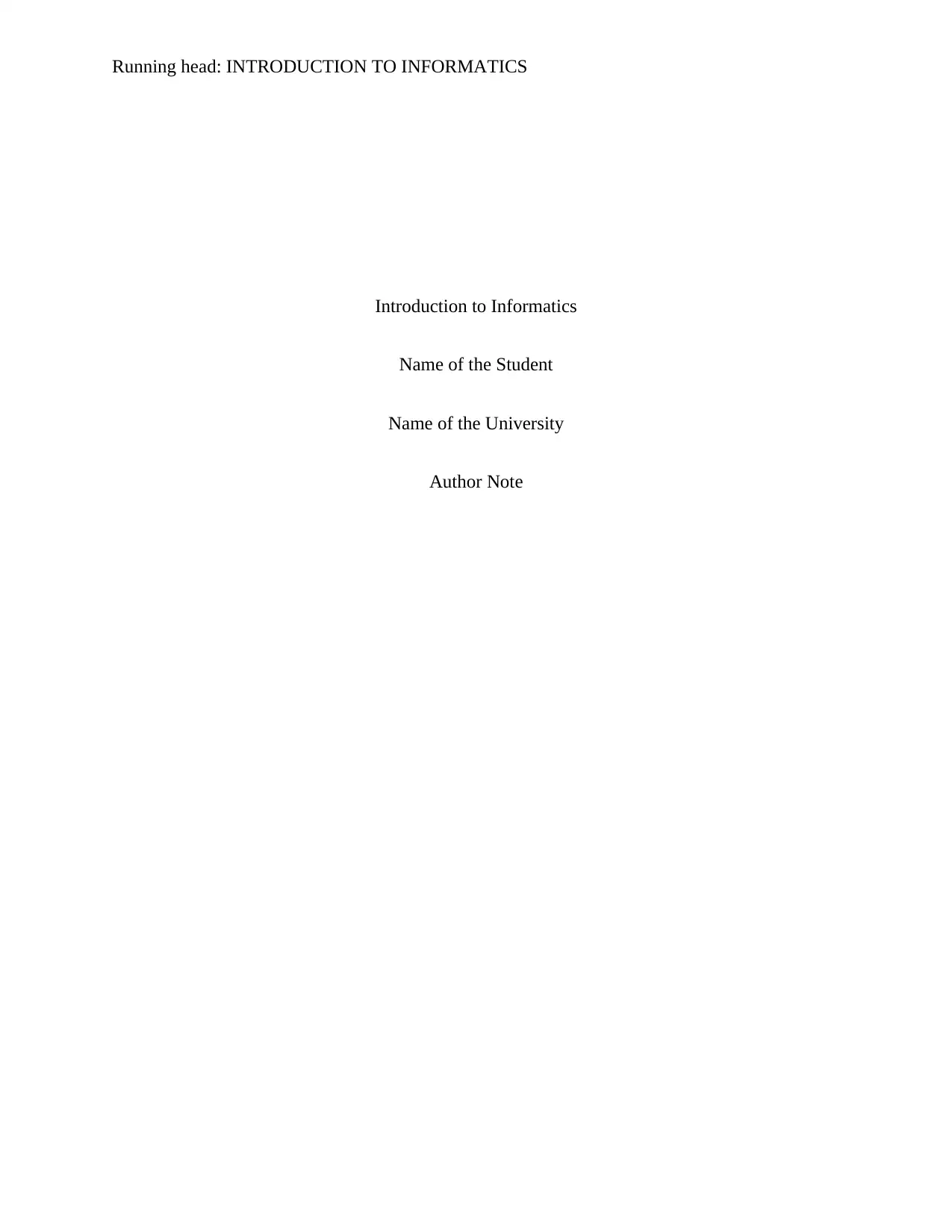
Running head: INTRODUCTION TO INFORMATICS
Introduction to Informatics
Name of the Student
Name of the University
Author Note
Introduction to Informatics
Name of the Student
Name of the University
Author Note
Paraphrase This Document
Need a fresh take? Get an instant paraphrase of this document with our AI Paraphraser
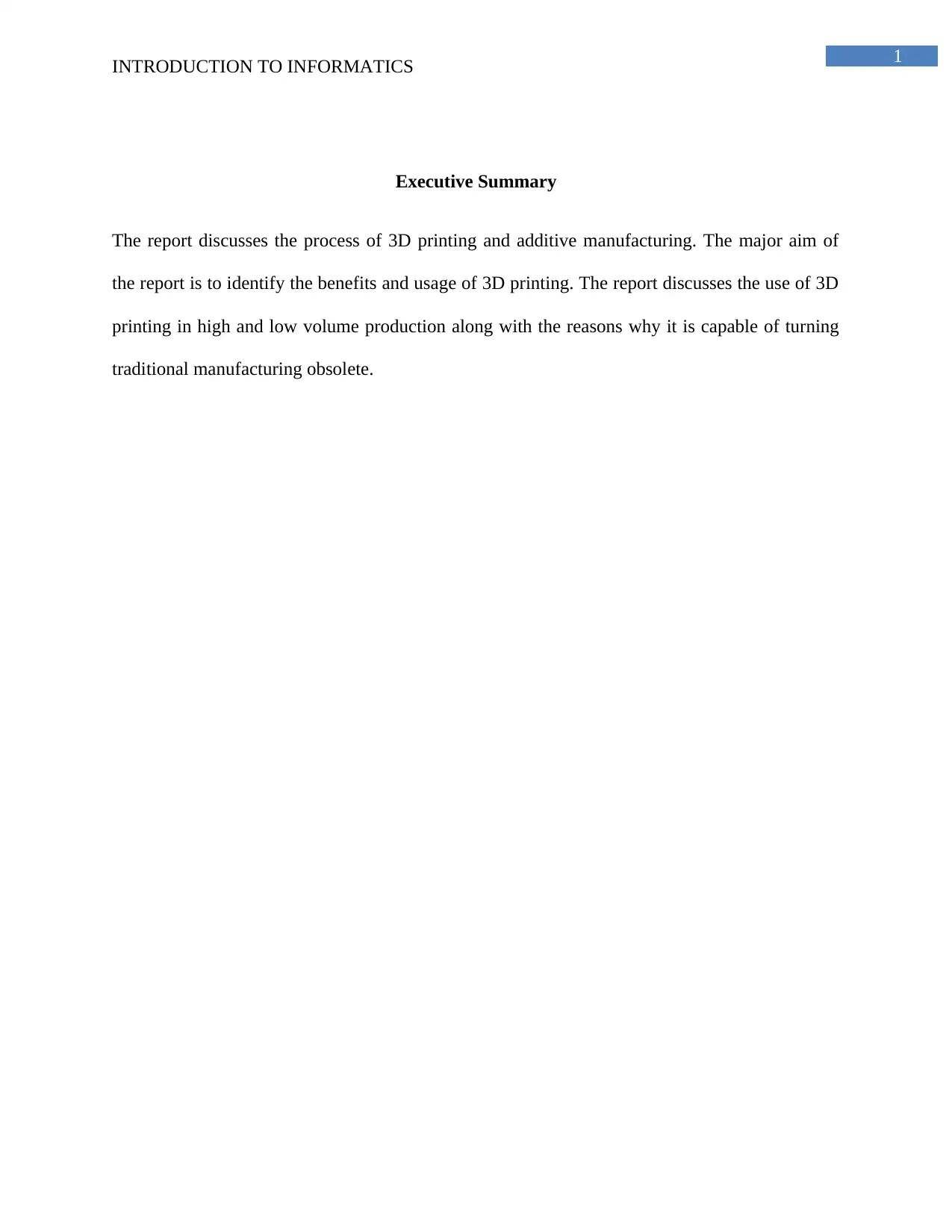
1
INTRODUCTION TO INFORMATICS
Executive Summary
The report discusses the process of 3D printing and additive manufacturing. The major aim of
the report is to identify the benefits and usage of 3D printing. The report discusses the use of 3D
printing in high and low volume production along with the reasons why it is capable of turning
traditional manufacturing obsolete.
INTRODUCTION TO INFORMATICS
Executive Summary
The report discusses the process of 3D printing and additive manufacturing. The major aim of
the report is to identify the benefits and usage of 3D printing. The report discusses the use of 3D
printing in high and low volume production along with the reasons why it is capable of turning
traditional manufacturing obsolete.
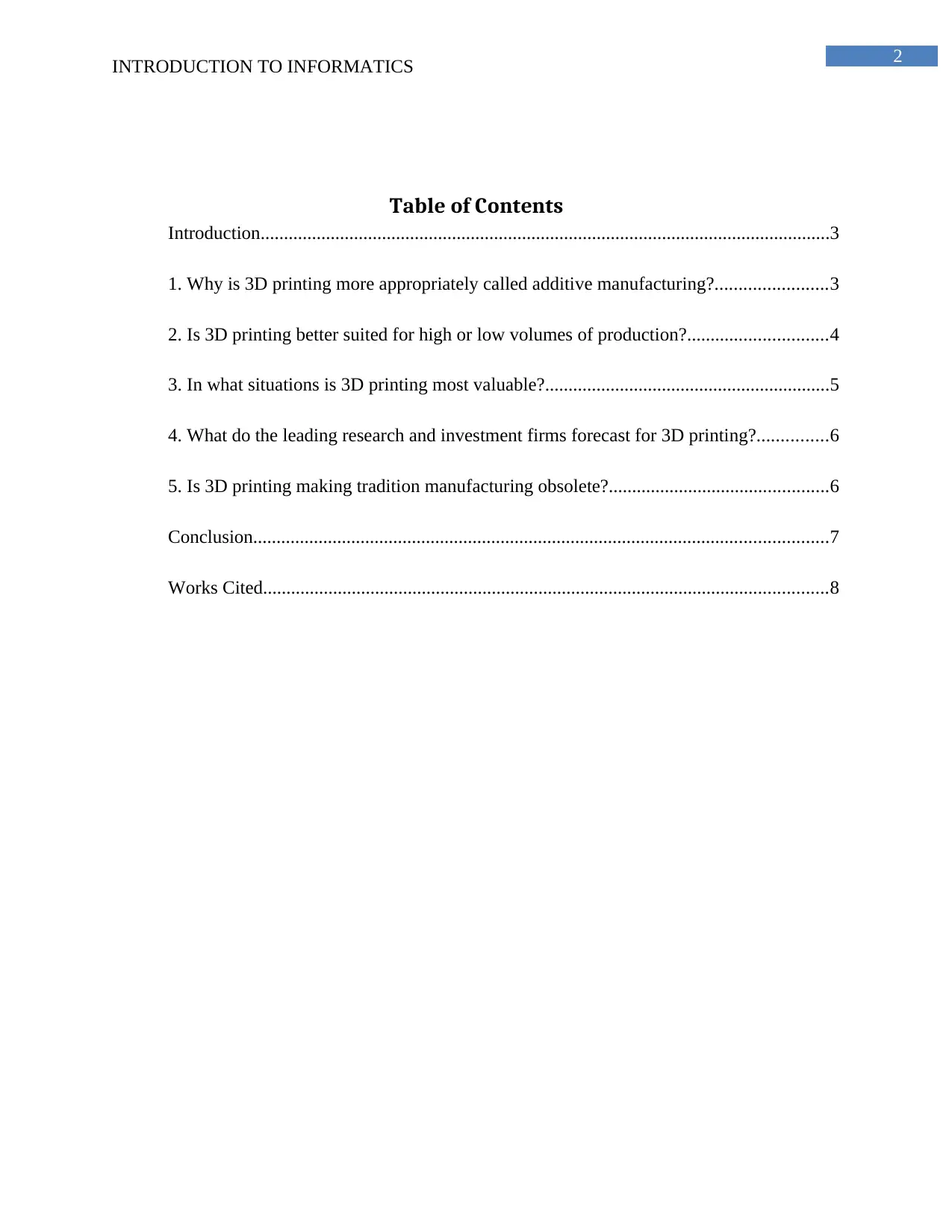
2
INTRODUCTION TO INFORMATICS
Table of Contents
Introduction..........................................................................................................................3
1. Why is 3D printing more appropriately called additive manufacturing?........................3
2. Is 3D printing better suited for high or low volumes of production?..............................4
3. In what situations is 3D printing most valuable?.............................................................5
4. What do the leading research and investment firms forecast for 3D printing?...............6
5. Is 3D printing making tradition manufacturing obsolete?...............................................6
Conclusion...........................................................................................................................7
Works Cited.........................................................................................................................8
INTRODUCTION TO INFORMATICS
Table of Contents
Introduction..........................................................................................................................3
1. Why is 3D printing more appropriately called additive manufacturing?........................3
2. Is 3D printing better suited for high or low volumes of production?..............................4
3. In what situations is 3D printing most valuable?.............................................................5
4. What do the leading research and investment firms forecast for 3D printing?...............6
5. Is 3D printing making tradition manufacturing obsolete?...............................................6
Conclusion...........................................................................................................................7
Works Cited.........................................................................................................................8
⊘ This is a preview!⊘
Do you want full access?
Subscribe today to unlock all pages.

Trusted by 1+ million students worldwide
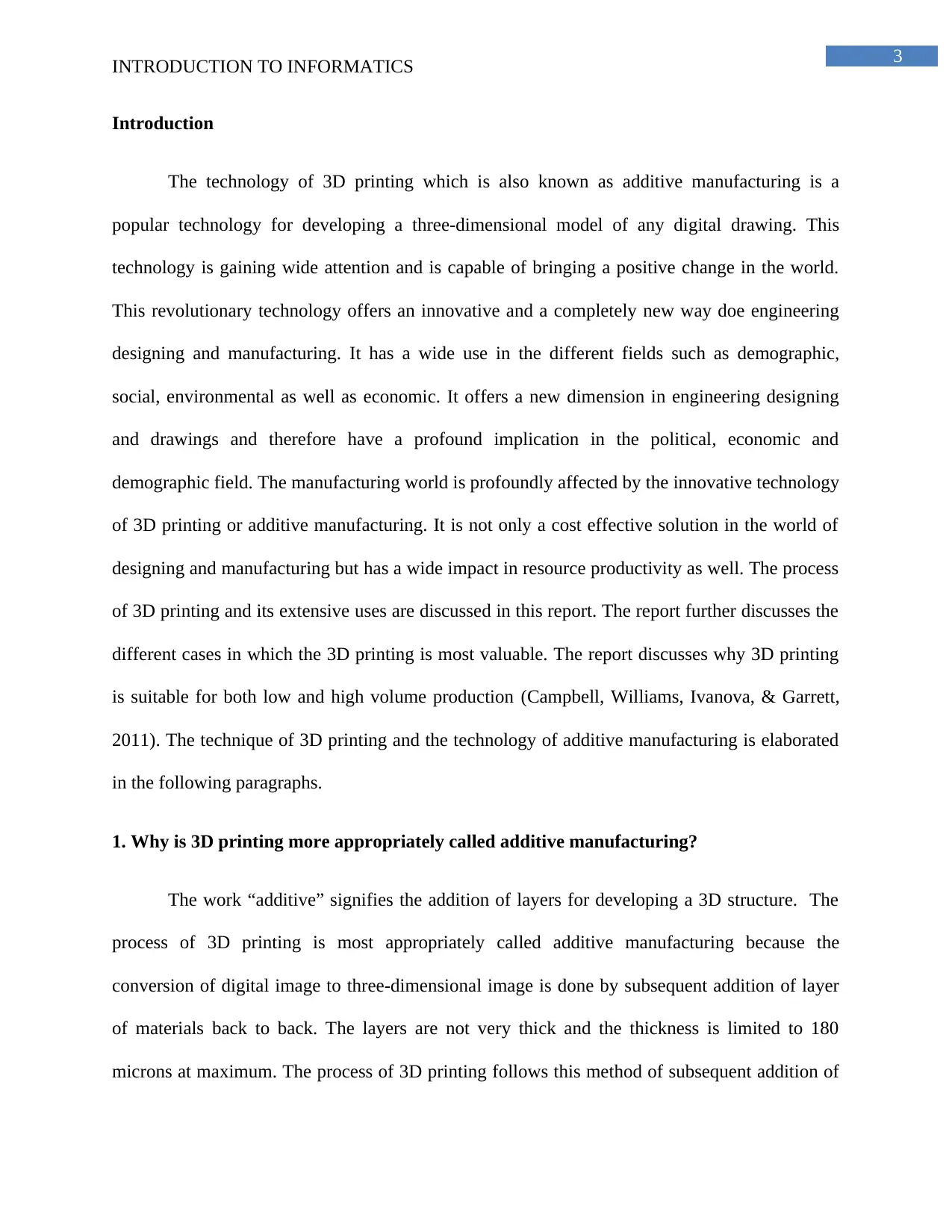
3
INTRODUCTION TO INFORMATICS
Introduction
The technology of 3D printing which is also known as additive manufacturing is a
popular technology for developing a three-dimensional model of any digital drawing. This
technology is gaining wide attention and is capable of bringing a positive change in the world.
This revolutionary technology offers an innovative and a completely new way doe engineering
designing and manufacturing. It has a wide use in the different fields such as demographic,
social, environmental as well as economic. It offers a new dimension in engineering designing
and drawings and therefore have a profound implication in the political, economic and
demographic field. The manufacturing world is profoundly affected by the innovative technology
of 3D printing or additive manufacturing. It is not only a cost effective solution in the world of
designing and manufacturing but has a wide impact in resource productivity as well. The process
of 3D printing and its extensive uses are discussed in this report. The report further discusses the
different cases in which the 3D printing is most valuable. The report discusses why 3D printing
is suitable for both low and high volume production (Campbell, Williams, Ivanova, & Garrett,
2011). The technique of 3D printing and the technology of additive manufacturing is elaborated
in the following paragraphs.
1. Why is 3D printing more appropriately called additive manufacturing?
The work “additive” signifies the addition of layers for developing a 3D structure. The
process of 3D printing is most appropriately called additive manufacturing because the
conversion of digital image to three-dimensional image is done by subsequent addition of layer
of materials back to back. The layers are not very thick and the thickness is limited to 180
microns at maximum. The process of 3D printing follows this method of subsequent addition of
INTRODUCTION TO INFORMATICS
Introduction
The technology of 3D printing which is also known as additive manufacturing is a
popular technology for developing a three-dimensional model of any digital drawing. This
technology is gaining wide attention and is capable of bringing a positive change in the world.
This revolutionary technology offers an innovative and a completely new way doe engineering
designing and manufacturing. It has a wide use in the different fields such as demographic,
social, environmental as well as economic. It offers a new dimension in engineering designing
and drawings and therefore have a profound implication in the political, economic and
demographic field. The manufacturing world is profoundly affected by the innovative technology
of 3D printing or additive manufacturing. It is not only a cost effective solution in the world of
designing and manufacturing but has a wide impact in resource productivity as well. The process
of 3D printing and its extensive uses are discussed in this report. The report further discusses the
different cases in which the 3D printing is most valuable. The report discusses why 3D printing
is suitable for both low and high volume production (Campbell, Williams, Ivanova, & Garrett,
2011). The technique of 3D printing and the technology of additive manufacturing is elaborated
in the following paragraphs.
1. Why is 3D printing more appropriately called additive manufacturing?
The work “additive” signifies the addition of layers for developing a 3D structure. The
process of 3D printing is most appropriately called additive manufacturing because the
conversion of digital image to three-dimensional image is done by subsequent addition of layer
of materials back to back. The layers are not very thick and the thickness is limited to 180
microns at maximum. The process of 3D printing follows this method of subsequent addition of
Paraphrase This Document
Need a fresh take? Get an instant paraphrase of this document with our AI Paraphraser
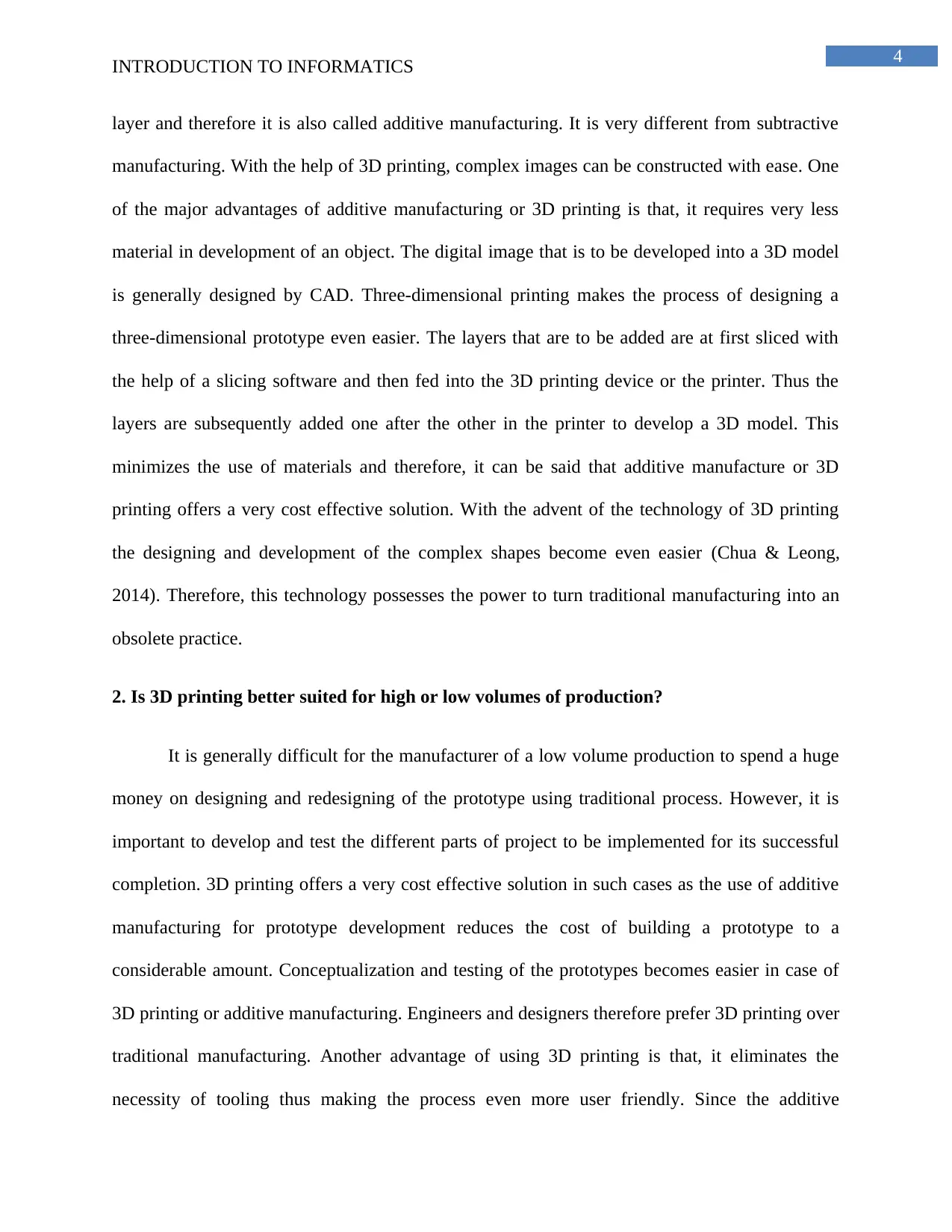
4
INTRODUCTION TO INFORMATICS
layer and therefore it is also called additive manufacturing. It is very different from subtractive
manufacturing. With the help of 3D printing, complex images can be constructed with ease. One
of the major advantages of additive manufacturing or 3D printing is that, it requires very less
material in development of an object. The digital image that is to be developed into a 3D model
is generally designed by CAD. Three-dimensional printing makes the process of designing a
three-dimensional prototype even easier. The layers that are to be added are at first sliced with
the help of a slicing software and then fed into the 3D printing device or the printer. Thus the
layers are subsequently added one after the other in the printer to develop a 3D model. This
minimizes the use of materials and therefore, it can be said that additive manufacture or 3D
printing offers a very cost effective solution. With the advent of the technology of 3D printing
the designing and development of the complex shapes become even easier (Chua & Leong,
2014). Therefore, this technology possesses the power to turn traditional manufacturing into an
obsolete practice.
2. Is 3D printing better suited for high or low volumes of production?
It is generally difficult for the manufacturer of a low volume production to spend a huge
money on designing and redesigning of the prototype using traditional process. However, it is
important to develop and test the different parts of project to be implemented for its successful
completion. 3D printing offers a very cost effective solution in such cases as the use of additive
manufacturing for prototype development reduces the cost of building a prototype to a
considerable amount. Conceptualization and testing of the prototypes becomes easier in case of
3D printing or additive manufacturing. Engineers and designers therefore prefer 3D printing over
traditional manufacturing. Another advantage of using 3D printing is that, it eliminates the
necessity of tooling thus making the process even more user friendly. Since the additive
INTRODUCTION TO INFORMATICS
layer and therefore it is also called additive manufacturing. It is very different from subtractive
manufacturing. With the help of 3D printing, complex images can be constructed with ease. One
of the major advantages of additive manufacturing or 3D printing is that, it requires very less
material in development of an object. The digital image that is to be developed into a 3D model
is generally designed by CAD. Three-dimensional printing makes the process of designing a
three-dimensional prototype even easier. The layers that are to be added are at first sliced with
the help of a slicing software and then fed into the 3D printing device or the printer. Thus the
layers are subsequently added one after the other in the printer to develop a 3D model. This
minimizes the use of materials and therefore, it can be said that additive manufacture or 3D
printing offers a very cost effective solution. With the advent of the technology of 3D printing
the designing and development of the complex shapes become even easier (Chua & Leong,
2014). Therefore, this technology possesses the power to turn traditional manufacturing into an
obsolete practice.
2. Is 3D printing better suited for high or low volumes of production?
It is generally difficult for the manufacturer of a low volume production to spend a huge
money on designing and redesigning of the prototype using traditional process. However, it is
important to develop and test the different parts of project to be implemented for its successful
completion. 3D printing offers a very cost effective solution in such cases as the use of additive
manufacturing for prototype development reduces the cost of building a prototype to a
considerable amount. Conceptualization and testing of the prototypes becomes easier in case of
3D printing or additive manufacturing. Engineers and designers therefore prefer 3D printing over
traditional manufacturing. Another advantage of using 3D printing is that, it eliminates the
necessity of tooling thus making the process even more user friendly. Since the additive
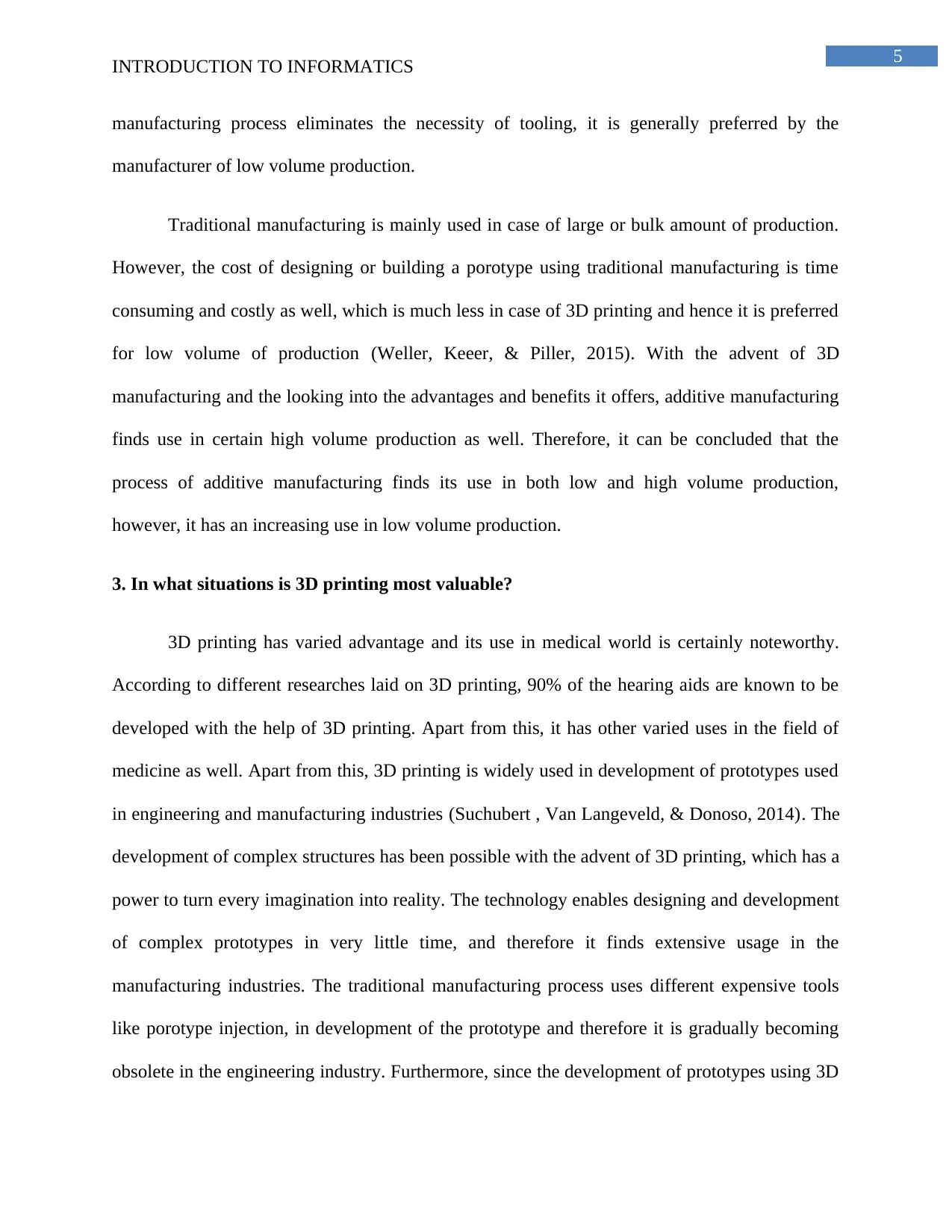
5
INTRODUCTION TO INFORMATICS
manufacturing process eliminates the necessity of tooling, it is generally preferred by the
manufacturer of low volume production.
Traditional manufacturing is mainly used in case of large or bulk amount of production.
However, the cost of designing or building a porotype using traditional manufacturing is time
consuming and costly as well, which is much less in case of 3D printing and hence it is preferred
for low volume of production (Weller, Keeer, & Piller, 2015). With the advent of 3D
manufacturing and the looking into the advantages and benefits it offers, additive manufacturing
finds use in certain high volume production as well. Therefore, it can be concluded that the
process of additive manufacturing finds its use in both low and high volume production,
however, it has an increasing use in low volume production.
3. In what situations is 3D printing most valuable?
3D printing has varied advantage and its use in medical world is certainly noteworthy.
According to different researches laid on 3D printing, 90% of the hearing aids are known to be
developed with the help of 3D printing. Apart from this, it has other varied uses in the field of
medicine as well. Apart from this, 3D printing is widely used in development of prototypes used
in engineering and manufacturing industries (Suchubert , Van Langeveld, & Donoso, 2014). The
development of complex structures has been possible with the advent of 3D printing, which has a
power to turn every imagination into reality. The technology enables designing and development
of complex prototypes in very little time, and therefore it finds extensive usage in the
manufacturing industries. The traditional manufacturing process uses different expensive tools
like porotype injection, in development of the prototype and therefore it is gradually becoming
obsolete in the engineering industry. Furthermore, since the development of prototypes using 3D
INTRODUCTION TO INFORMATICS
manufacturing process eliminates the necessity of tooling, it is generally preferred by the
manufacturer of low volume production.
Traditional manufacturing is mainly used in case of large or bulk amount of production.
However, the cost of designing or building a porotype using traditional manufacturing is time
consuming and costly as well, which is much less in case of 3D printing and hence it is preferred
for low volume of production (Weller, Keeer, & Piller, 2015). With the advent of 3D
manufacturing and the looking into the advantages and benefits it offers, additive manufacturing
finds use in certain high volume production as well. Therefore, it can be concluded that the
process of additive manufacturing finds its use in both low and high volume production,
however, it has an increasing use in low volume production.
3. In what situations is 3D printing most valuable?
3D printing has varied advantage and its use in medical world is certainly noteworthy.
According to different researches laid on 3D printing, 90% of the hearing aids are known to be
developed with the help of 3D printing. Apart from this, it has other varied uses in the field of
medicine as well. Apart from this, 3D printing is widely used in development of prototypes used
in engineering and manufacturing industries (Suchubert , Van Langeveld, & Donoso, 2014). The
development of complex structures has been possible with the advent of 3D printing, which has a
power to turn every imagination into reality. The technology enables designing and development
of complex prototypes in very little time, and therefore it finds extensive usage in the
manufacturing industries. The traditional manufacturing process uses different expensive tools
like porotype injection, in development of the prototype and therefore it is gradually becoming
obsolete in the engineering industry. Furthermore, since the development of prototypes using 3D
⊘ This is a preview!⊘
Do you want full access?
Subscribe today to unlock all pages.

Trusted by 1+ million students worldwide
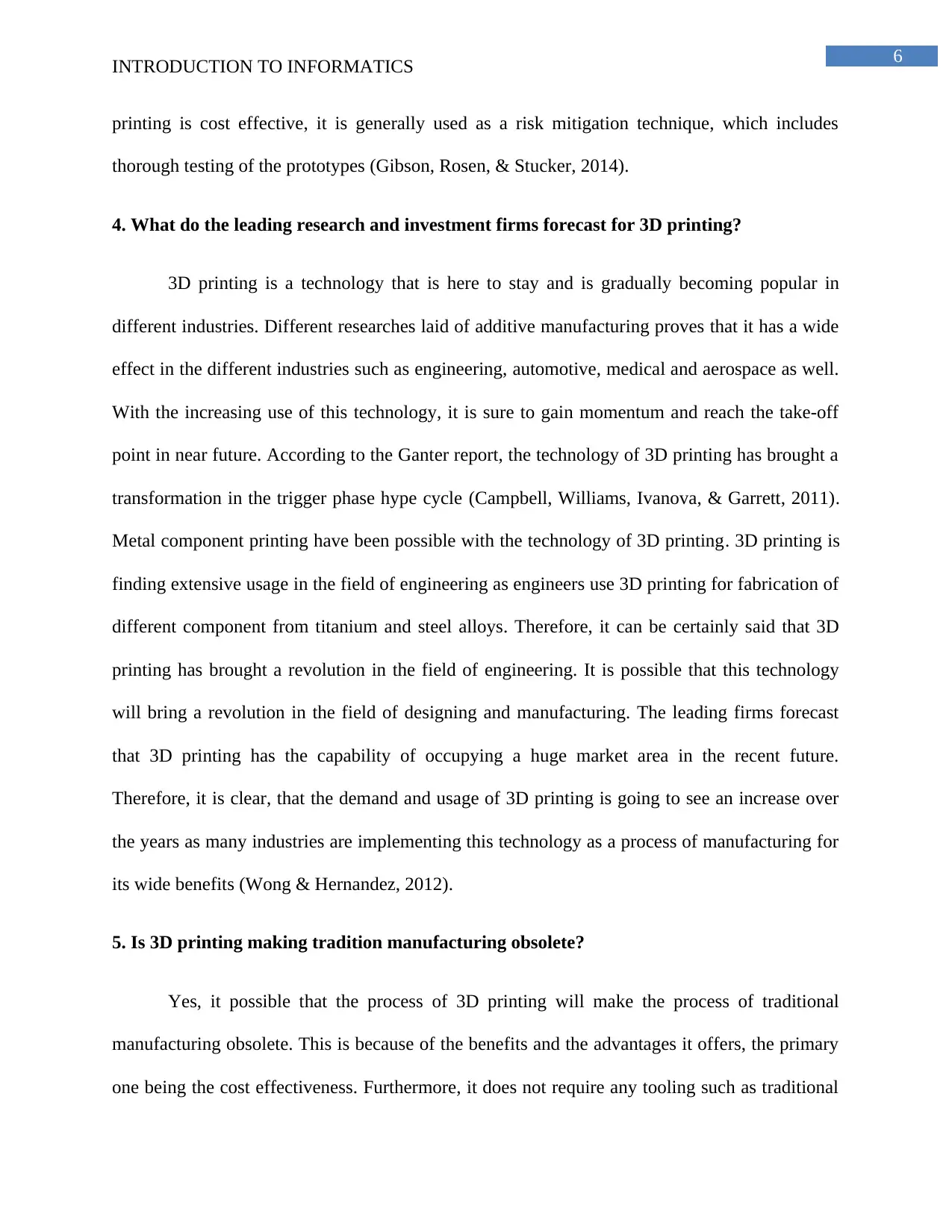
6
INTRODUCTION TO INFORMATICS
printing is cost effective, it is generally used as a risk mitigation technique, which includes
thorough testing of the prototypes (Gibson, Rosen, & Stucker, 2014).
4. What do the leading research and investment firms forecast for 3D printing?
3D printing is a technology that is here to stay and is gradually becoming popular in
different industries. Different researches laid of additive manufacturing proves that it has a wide
effect in the different industries such as engineering, automotive, medical and aerospace as well.
With the increasing use of this technology, it is sure to gain momentum and reach the take-off
point in near future. According to the Ganter report, the technology of 3D printing has brought a
transformation in the trigger phase hype cycle (Campbell, Williams, Ivanova, & Garrett, 2011).
Metal component printing have been possible with the technology of 3D printing. 3D printing is
finding extensive usage in the field of engineering as engineers use 3D printing for fabrication of
different component from titanium and steel alloys. Therefore, it can be certainly said that 3D
printing has brought a revolution in the field of engineering. It is possible that this technology
will bring a revolution in the field of designing and manufacturing. The leading firms forecast
that 3D printing has the capability of occupying a huge market area in the recent future.
Therefore, it is clear, that the demand and usage of 3D printing is going to see an increase over
the years as many industries are implementing this technology as a process of manufacturing for
its wide benefits (Wong & Hernandez, 2012).
5. Is 3D printing making tradition manufacturing obsolete?
Yes, it possible that the process of 3D printing will make the process of traditional
manufacturing obsolete. This is because of the benefits and the advantages it offers, the primary
one being the cost effectiveness. Furthermore, it does not require any tooling such as traditional
INTRODUCTION TO INFORMATICS
printing is cost effective, it is generally used as a risk mitigation technique, which includes
thorough testing of the prototypes (Gibson, Rosen, & Stucker, 2014).
4. What do the leading research and investment firms forecast for 3D printing?
3D printing is a technology that is here to stay and is gradually becoming popular in
different industries. Different researches laid of additive manufacturing proves that it has a wide
effect in the different industries such as engineering, automotive, medical and aerospace as well.
With the increasing use of this technology, it is sure to gain momentum and reach the take-off
point in near future. According to the Ganter report, the technology of 3D printing has brought a
transformation in the trigger phase hype cycle (Campbell, Williams, Ivanova, & Garrett, 2011).
Metal component printing have been possible with the technology of 3D printing. 3D printing is
finding extensive usage in the field of engineering as engineers use 3D printing for fabrication of
different component from titanium and steel alloys. Therefore, it can be certainly said that 3D
printing has brought a revolution in the field of engineering. It is possible that this technology
will bring a revolution in the field of designing and manufacturing. The leading firms forecast
that 3D printing has the capability of occupying a huge market area in the recent future.
Therefore, it is clear, that the demand and usage of 3D printing is going to see an increase over
the years as many industries are implementing this technology as a process of manufacturing for
its wide benefits (Wong & Hernandez, 2012).
5. Is 3D printing making tradition manufacturing obsolete?
Yes, it possible that the process of 3D printing will make the process of traditional
manufacturing obsolete. This is because of the benefits and the advantages it offers, the primary
one being the cost effectiveness. Furthermore, it does not require any tooling such as traditional
Paraphrase This Document
Need a fresh take? Get an instant paraphrase of this document with our AI Paraphraser
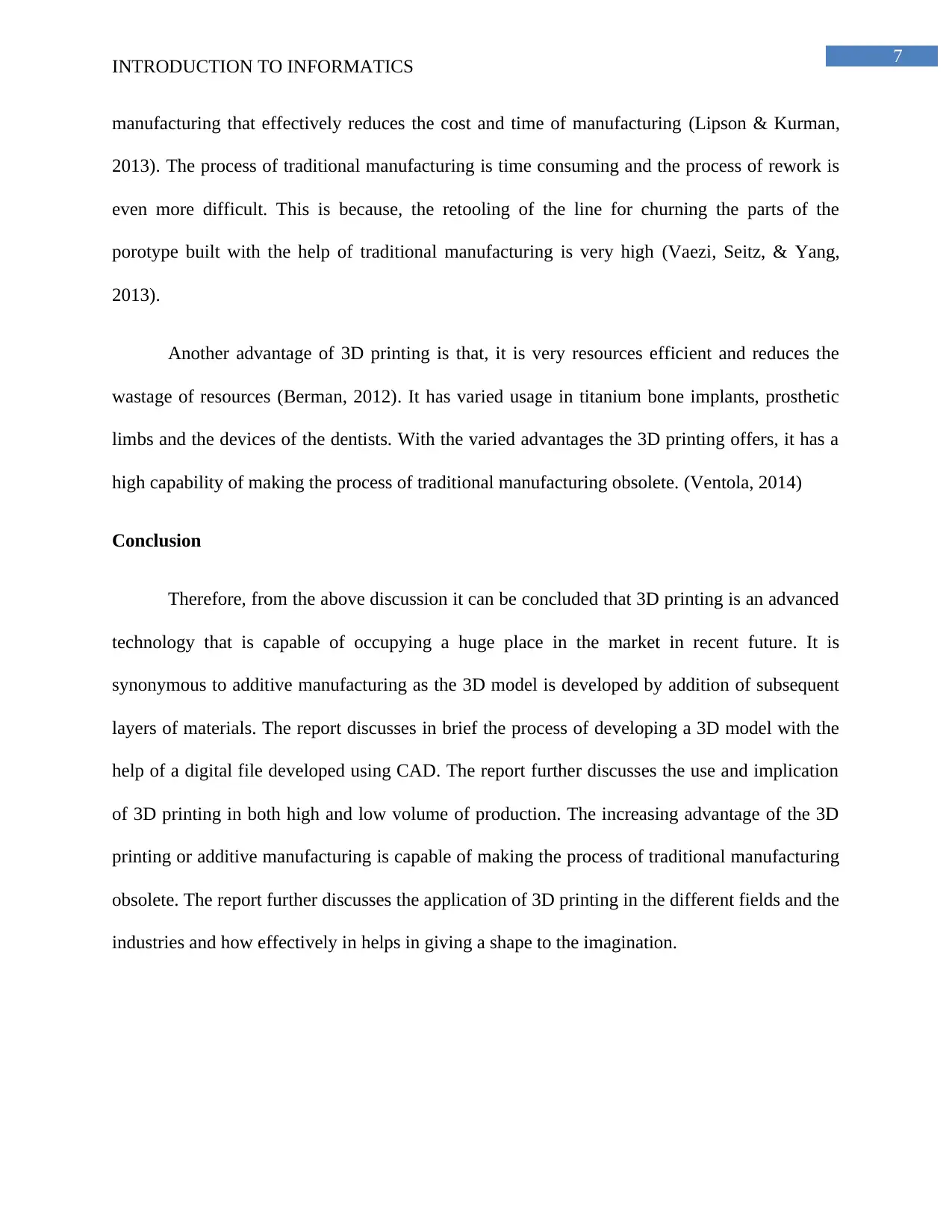
7
INTRODUCTION TO INFORMATICS
manufacturing that effectively reduces the cost and time of manufacturing (Lipson & Kurman,
2013). The process of traditional manufacturing is time consuming and the process of rework is
even more difficult. This is because, the retooling of the line for churning the parts of the
porotype built with the help of traditional manufacturing is very high (Vaezi, Seitz, & Yang,
2013).
Another advantage of 3D printing is that, it is very resources efficient and reduces the
wastage of resources (Berman, 2012). It has varied usage in titanium bone implants, prosthetic
limbs and the devices of the dentists. With the varied advantages the 3D printing offers, it has a
high capability of making the process of traditional manufacturing obsolete. (Ventola, 2014)
Conclusion
Therefore, from the above discussion it can be concluded that 3D printing is an advanced
technology that is capable of occupying a huge place in the market in recent future. It is
synonymous to additive manufacturing as the 3D model is developed by addition of subsequent
layers of materials. The report discusses in brief the process of developing a 3D model with the
help of a digital file developed using CAD. The report further discusses the use and implication
of 3D printing in both high and low volume of production. The increasing advantage of the 3D
printing or additive manufacturing is capable of making the process of traditional manufacturing
obsolete. The report further discusses the application of 3D printing in the different fields and the
industries and how effectively in helps in giving a shape to the imagination.
INTRODUCTION TO INFORMATICS
manufacturing that effectively reduces the cost and time of manufacturing (Lipson & Kurman,
2013). The process of traditional manufacturing is time consuming and the process of rework is
even more difficult. This is because, the retooling of the line for churning the parts of the
porotype built with the help of traditional manufacturing is very high (Vaezi, Seitz, & Yang,
2013).
Another advantage of 3D printing is that, it is very resources efficient and reduces the
wastage of resources (Berman, 2012). It has varied usage in titanium bone implants, prosthetic
limbs and the devices of the dentists. With the varied advantages the 3D printing offers, it has a
high capability of making the process of traditional manufacturing obsolete. (Ventola, 2014)
Conclusion
Therefore, from the above discussion it can be concluded that 3D printing is an advanced
technology that is capable of occupying a huge place in the market in recent future. It is
synonymous to additive manufacturing as the 3D model is developed by addition of subsequent
layers of materials. The report discusses in brief the process of developing a 3D model with the
help of a digital file developed using CAD. The report further discusses the use and implication
of 3D printing in both high and low volume of production. The increasing advantage of the 3D
printing or additive manufacturing is capable of making the process of traditional manufacturing
obsolete. The report further discusses the application of 3D printing in the different fields and the
industries and how effectively in helps in giving a shape to the imagination.
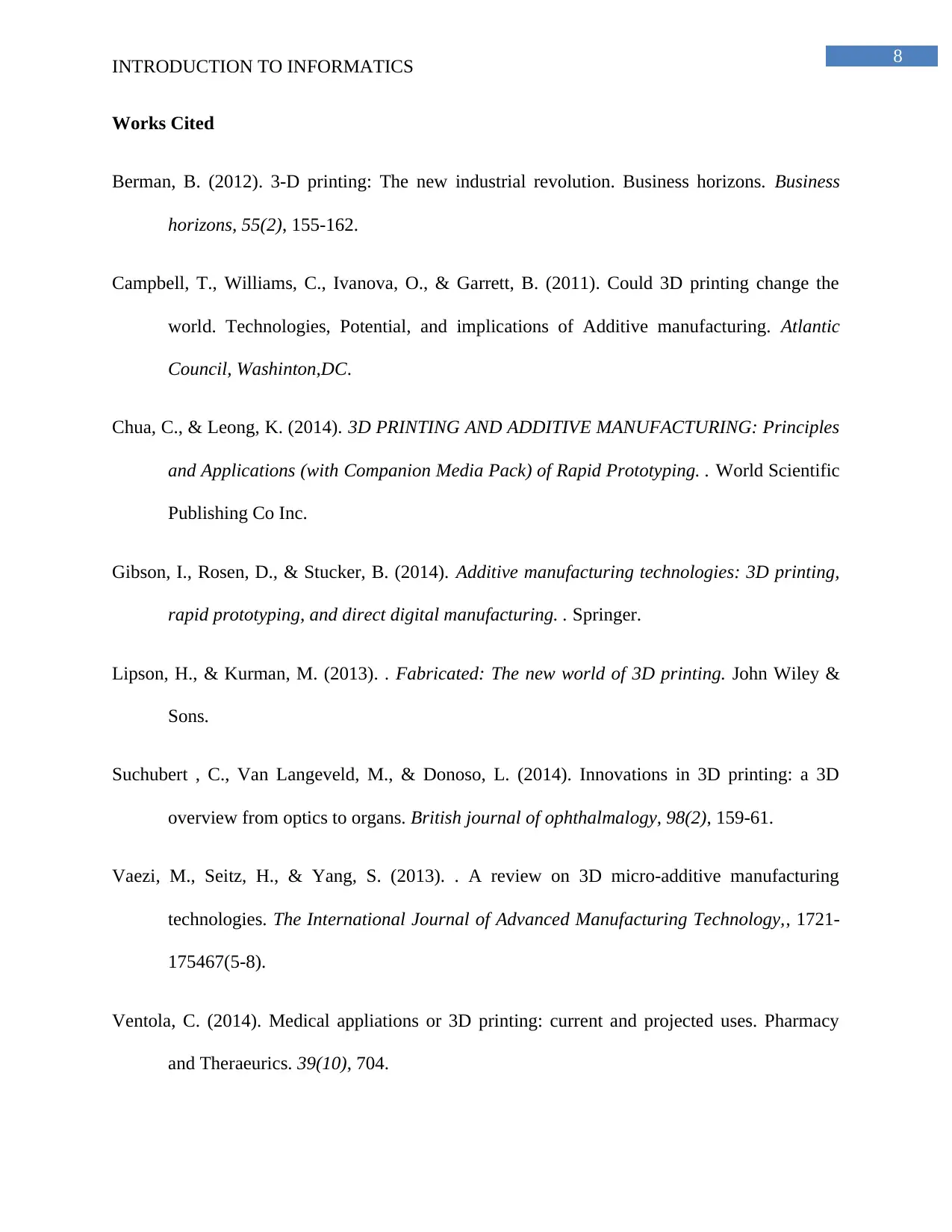
8
INTRODUCTION TO INFORMATICS
Works Cited
Berman, B. (2012). 3-D printing: The new industrial revolution. Business horizons. Business
horizons, 55(2), 155-162.
Campbell, T., Williams, C., Ivanova, O., & Garrett, B. (2011). Could 3D printing change the
world. Technologies, Potential, and implications of Additive manufacturing. Atlantic
Council, Washinton,DC.
Chua, C., & Leong, K. (2014). 3D PRINTING AND ADDITIVE MANUFACTURING: Principles
and Applications (with Companion Media Pack) of Rapid Prototyping. . World Scientific
Publishing Co Inc.
Gibson, I., Rosen, D., & Stucker, B. (2014). Additive manufacturing technologies: 3D printing,
rapid prototyping, and direct digital manufacturing. . Springer.
Lipson, H., & Kurman, M. (2013). . Fabricated: The new world of 3D printing. John Wiley &
Sons.
Suchubert , C., Van Langeveld, M., & Donoso, L. (2014). Innovations in 3D printing: a 3D
overview from optics to organs. British journal of ophthalmalogy, 98(2), 159-61.
Vaezi, M., Seitz, H., & Yang, S. (2013). . A review on 3D micro-additive manufacturing
technologies. The International Journal of Advanced Manufacturing Technology,, 1721-
175467(5-8).
Ventola, C. (2014). Medical appliations or 3D printing: current and projected uses. Pharmacy
and Theraeurics. 39(10), 704.
INTRODUCTION TO INFORMATICS
Works Cited
Berman, B. (2012). 3-D printing: The new industrial revolution. Business horizons. Business
horizons, 55(2), 155-162.
Campbell, T., Williams, C., Ivanova, O., & Garrett, B. (2011). Could 3D printing change the
world. Technologies, Potential, and implications of Additive manufacturing. Atlantic
Council, Washinton,DC.
Chua, C., & Leong, K. (2014). 3D PRINTING AND ADDITIVE MANUFACTURING: Principles
and Applications (with Companion Media Pack) of Rapid Prototyping. . World Scientific
Publishing Co Inc.
Gibson, I., Rosen, D., & Stucker, B. (2014). Additive manufacturing technologies: 3D printing,
rapid prototyping, and direct digital manufacturing. . Springer.
Lipson, H., & Kurman, M. (2013). . Fabricated: The new world of 3D printing. John Wiley &
Sons.
Suchubert , C., Van Langeveld, M., & Donoso, L. (2014). Innovations in 3D printing: a 3D
overview from optics to organs. British journal of ophthalmalogy, 98(2), 159-61.
Vaezi, M., Seitz, H., & Yang, S. (2013). . A review on 3D micro-additive manufacturing
technologies. The International Journal of Advanced Manufacturing Technology,, 1721-
175467(5-8).
Ventola, C. (2014). Medical appliations or 3D printing: current and projected uses. Pharmacy
and Theraeurics. 39(10), 704.
⊘ This is a preview!⊘
Do you want full access?
Subscribe today to unlock all pages.

Trusted by 1+ million students worldwide
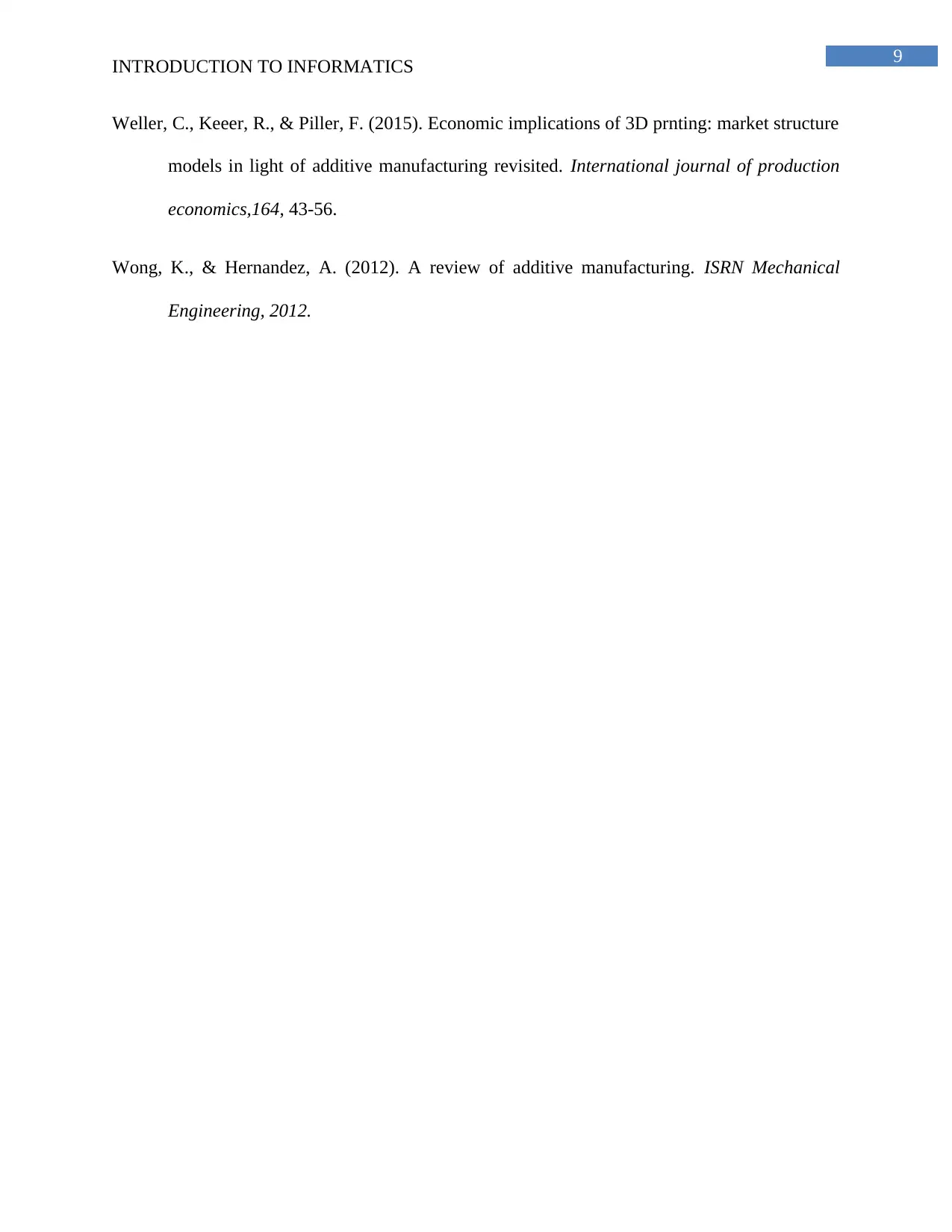
9
INTRODUCTION TO INFORMATICS
Weller, C., Keeer, R., & Piller, F. (2015). Economic implications of 3D prnting: market structure
models in light of additive manufacturing revisited. International journal of production
economics,164, 43-56.
Wong, K., & Hernandez, A. (2012). A review of additive manufacturing. ISRN Mechanical
Engineering, 2012.
INTRODUCTION TO INFORMATICS
Weller, C., Keeer, R., & Piller, F. (2015). Economic implications of 3D prnting: market structure
models in light of additive manufacturing revisited. International journal of production
economics,164, 43-56.
Wong, K., & Hernandez, A. (2012). A review of additive manufacturing. ISRN Mechanical
Engineering, 2012.
1 out of 10
Related Documents
Your All-in-One AI-Powered Toolkit for Academic Success.
+13062052269
info@desklib.com
Available 24*7 on WhatsApp / Email
![[object Object]](/_next/static/media/star-bottom.7253800d.svg)
Unlock your academic potential
Copyright © 2020–2025 A2Z Services. All Rights Reserved. Developed and managed by ZUCOL.





